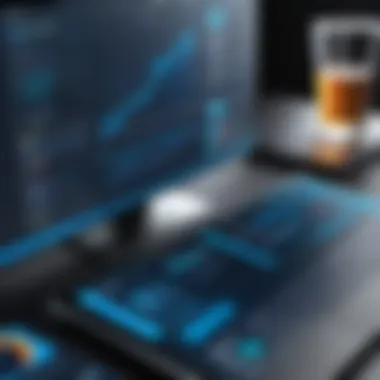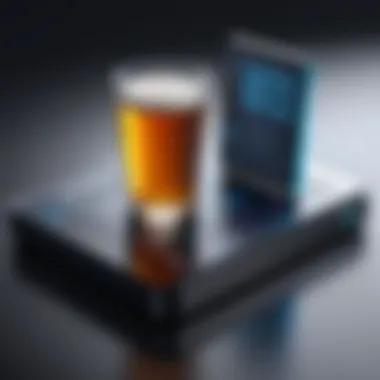Comprehensive Overview of Bar Software Systems


Intro
In the dynamic and competitive landscape of the hospitality industry, the effective management of bar operations is crucial. Harnessing the power of bar software systems has become a necessary strategy for businesses aiming to optimize their services and increase profitability. This article delves into the core aspects of these software systems, examining key functionalities, benefits, and potential challenges that operators may encounter during implementation. Furthermore, it provides insight into future trends that could shape the bar management software sector.
Key Features
Overview of Core Features
Bar software systems boast several essential features designed to streamline operations. The key functionalities that operators often expect include:
- Inventory Management: Effective control over stock levels, monitoring of usage rates, and alerts for low stock facilitate the reduction of waste and theft.
- Point of Sale (POS) System: A user-friendly POS interface enables efficient order taking and payment processing, vital for fast-paced bar environments.
- Reporting and Analytics: Generating detailed sales reports aids in understanding performance trends and maximizing revenue potential.
- Staff Management: Tools for scheduling and tracking employee performance contribute to improved labor efficiency.
These features work in unison to enhance operational efficiency.
User Interface and Experience
The user interface of bar software systems plays a significant role in operational success. An intuitive design ensures staff can quickly learn and use the system, thereby reducing training time. The integration of touchscreen capabilities often streamlines the order-taking process, making it faster and more reliable. Furthermore, customizable dashboards allow managers to access critical metrics at a glance, fostering informed decision-making. It is vital that the system prioritizes user experience to reduce frustration and increase productivity.
Pricing and Plans
Overview of Pricing Models
Pricing for bar software systems typically varies based on functionality and user base. Common models include:
- Subscription-Based: Monthly or annual fees that offer access to a suite of features, often including ongoing support and updates.
- One-Time Purchase: A lump payment for a perpetual license, which might require additional costs for upgrades.
- Commission-Based: Fees based on sales volume or transactions, aligning costs with business performance.
Understanding these models aids businesses in selecting the right option for their budgets and needs.
Comparison of Different Plans
Different providers offer various plans that cater to different sizes and types of establishments. For example, some systems like Toast or Square provide tiered plans with increasing features such as:
- Basic POS functionalities in their lower-tier plans.
- Advanced reporting and analytics in higher tiers.
- Enhanced customer relationship management tools for premium packages.
Operators should consider not only the initial costs but also the long-term value each plan offers.
"Selecting the right bar software is a balance between functionality and cost that ultimately influences operational success."
Foreword to Bar Software Systems
The advent of technology has brought significant changes to various industries, including hospitality. Among the most important developments are bar software systems, which play an essential role in optimizing operations and improving overall efficiency in bars and restaurants. These systems are designed to manage various aspects of bar operations, from inventory control to customer engagement. Understanding their importance helps businesses remain competitive in a dynamic market.
Defining Bar Software
Bar software refers to specialized systems created to automate and enhance bar management operations. These systems typically compress functionalities that help streamline business processes, including inventory management, sales tracking, and analytics. They enable bar staff to efficiently handle transactions, monitor supplies, and even manage customer preferences. By automating these tasks, bar software minimizes the dependency on manual processes, reducing errors and saving time.
Key features commonly found in bar software systems include:
- Point of Sale (POS) capabilities, which facilitate payment processing and sales reporting.
- Inventory tracking, allowing managers to monitor stock levels and automate reordering.
- Customer Relationship Management (CRM) features, which enable personalized service by keeping records of customer interactions.
- Analytics and reporting tools, providing insights into sales performance and trends.
History and Evolution
The evolution of bar software can be traced back to the early introduction of computerized systems in hospitality. In the late 20th century, simple cash register systems used paper reports for tracking sales. However, as technology advanced, the need for more sophisticated solutions led to the development of dedicated bar management software.
In the 1990s, POS systems began to incorporate more features, from digital sales tracking to basic inventory management. This transformation paved the way for modern bar software systems that integrate multiple functionalities into a single platform. By the 2000s, cloud technology emerged, further revolutionizing the industry. Cloud-based systems offered advantages like remote access, automatic updates, and scalable solutions that catered to businesses of all sizes.
Today, bar software systems continue to evolve, integrating cutting-edge technologies such as AI and machine learning to enhance user experience and operational efficiency. Startups and established companies alike invest in software solutions that not only meet immediate operational needs but also anticipate future demands within the hospitality sector.
Core Functionalities of Bar Software Systems
The core functionalities of bar software systems encompass essential features that streamline operations in a bar or restaurant setting. Understanding these functionalities is vital for decision-makers as they directly influence efficiency, profitability, and customer satisfaction. Each component plays a unique role in forming a well-rounded software solution that aids in daily management tasks while also supporting strategic decision-making.
Inventory Management


Inventory management is a critical aspect of bar operations. It involves organizing and tracking stock levels, order placement, and waste reduction. An effective inventory system can alert managers to low stock items, track usage patterns, and forecast future inventory needs. This functionality minimizes the risk of overstocking or running out of popular products, ultimately leading to better cash flow management. A bar that optimizes its inventory can reduce costs and improve service speed.
Point of Sale (POS) Features
POS features serve as the heartbeat of bar software systems. A modern POS system goes beyond simple transaction processing. It integrates payment processing, order taking, and performance reporting into a single platform. Fast and efficient transactions increase customer satisfaction and streamline service. Additionally, advanced POS systems can provide insights into sales trends, allowing managers to make data-driven decisions regarding menu adjustments or promotional activities.
Staff Management Tools
Staff management tools are another indispensable function of bar software systems. These tools help with scheduling, time tracking, and payroll management. Efficient staff scheduling ensures that the bar is adequately staffed during peak times, directly impacting service quality and employee morale. Furthermore, efficient time tracking minimizes payroll errors and ensures compliance with labor laws. By having a clear view of employee performance and availability, managers can allocate resources effectively and increase overall operational efficiency.
Customer Relationship Management
Customer Relationship Management (CRM) capabilities are essential for enhancing patron engagement. Bar software with CRM features allows tracking of customer preferences, purchase history, and feedback. By leveraging this data, bars can tailor marketing efforts and loyalty programs to better meet customer needs. A personalized approach not only fosters customer loyalty but also promotes repeat business. Understanding customer demographics and trends can aid bar owners in setting competitive strategies that resonate with their audience.
"Investing in comprehensive bar software systems is fundamental for modern hospitality businesses, driving both operational success and customer loyalty."
The core functionalities discussed above form a cohesive framework that drives the success of any bar management strategy. Each element reinforces the others, creating a system that enhances operational efficiency and promotes a positive customer experience.
Benefits of Implementing Bar Software Systems
The integration of bar software systems within hospitality settings offers various benefits that significantly improve operations and customer satisfaction. This section will explore why implementing such systems is essential for modern bars, focusing on key elements like operational efficiency, customer experience, decision-making through data, and costs.
Increased Operational Efficiency
Bar software systems streamline numerous processes related to managing inventory, staff, and sales. For instance, automated inventory management helps prevent overstocking or stockouts. When inventory levels are monitored in real time, it reduces the time staff spends manually tracking stock. Efficient Point of Sale (POS) systems enhance transaction speeds, which is crucial during peak hours.
Notably, with bar software, orders are processed faster, allowing servers to handle more customers simultaneously. This efficiency can lead to increased profitability, as the bar can serve more patrons in less time. Staff management features also allow for better scheduling and tracking of hours, resulting in optimized labor costs.
Enhanced Customer Experience
The use of bar software systems directly influences the customer experience. With quick and accurate order processing, customers have shorter wait times. Features such as integrated customer relationship management tools help staff remember past orders, fostering personalized service.
Moreover, customer feedback mechanisms integrated within software systems allow for continual improvement based on patrons' preferences and complaints. Positive experiences drive repeat business, so investing in quality bar software becomes a strategic move for retaining customers.
Data-Driven Decision Making
Bar software systems provide valuable insights through analytics and reporting features. Weekly or monthly sales reports help identify best-selling items and peak service times. This data enables managers to make informed decisions about promotions or menu adjustments.
Understanding trends and customer preferences can also influence purchasing decisions. For instance, knowing when certain drinks are popular allows a bar to adjust inventory purchasing patterns. In a competitive market, the ability to make data-driven decisions can be a deciding factor in a bar's success.
Cost Reduction
Investing in bar software systems may initially seem costly. However, the long-term savings often outweigh the initial expense. Automation of various tasks reduces labor costs, minimizes human error, and decreases waste associated with poor inventory management. For example, minimizing over-pouring or recognizing underperforming products can lead to significant savings.
Additionally, the reporting features within bar software provide insights that help optimize operational budgets. By understanding where money is being spent, management can make savvy financial decisions, ultimately reducing costs without sacrificing quality.
"Bar software systems not only simplify operations but also enhance profitability and create a better customer experience."
The implementation of bar software systems can streamline operations, enhance customer satisfaction, and lead to better financial performance. As bars continue to evolve, the advantages of using advanced software solutions become increasingly apparent.
Key Features to Consider
When evaluating bar software systems, understanding the key features is essential. These features directly affect efficiency, usability, and overall effectiveness of bar management. Selecting the right software can lead to improved workflows, better customer service, and enhanced data management.
Cloud-Based or On-Premises Solutions
Choosing between cloud-based and on-premises solutions is crucial. Cloud-based software provides flexibility, allowing access from anywhere and reducing the need for local storage. This is particularly beneficial for multiple locations or remote management. On the other hand, on-premises solutions may offer greater control over data and security, which can be vital for establishments concerned about sensitive information. Each option has its own set of merits and challenges, depending on the specific requirements of the bar. Thus, assessing these factors can influence a business's productivity.
Integration Capabilities
Integration capabilities are vital for a comprehensive bar software system. The ability to integrate with existing systems such as payment processors, accounting software, and inventory management tools can streamline operations significantly. When the systems communicate effectively, it reduces errors and saves time. A lack of integration can lead to redundancy and inconsistencies in data. Therefore, businesses need to prioritize software that supports seamless connections with other tools used in their operations. This interconnectedness boosts overall efficiency and promotes better decision-making by providing accurate real-time data.
Mobile Accessibility
In today’s fast-paced environment, mobile accessibility is more important than ever. Bar software that offers a mobile application allows staff to manage tasks on the go. This can include checking inventory, accessing sales reports, or responding to customer queries. Being able to perform these tasks remotely increases responsiveness and can enhance customer satisfaction. Furthermore, some mobile solutions come equipped with features like mobile payments, which can speed up transactions during busy hours. Ultimately, mobile accessibility fosters agility in operations.


Reporting and Analytics Features
Reporting and analytics are fundamental components of bar software systems. Effective software should provide insightful metrics regarding sales trends, customer behavior, and inventory turnover. These reports can reveal hidden opportunities or areas needing improvement. For instance, understanding which drinks are most popular during certain times can guide purchasing decisions and marketing efforts. Conversely, if data shows declining sales for specific items, adjustments can be made proactively. Companies that leverage these insights are better positioned to optimize their operations.
"Data-driven decisions are often the best decisions for business."
Challenges in Adopting Bar Software
Adopting bar software systems presents notable challenges that can impact operational efficiency. Understanding these obstacles is crucial for decision-makers. These challenges are not just about technology; they encompass various strategic considerations that can influence the success of implementation. Addressing them early can save time and resources, leading to smoother transitions and better outcomes.
Financial Investment
One of the most significant challenges is the financial investment involved in acquiring bar software. High upfront costs can deter some business owners from proceeding. Software choices vary greatly in pricing, and the initial costs can include not only the software itself but also hardware, installation, and ongoing subscription fees. Furthermore, comprehensive solutions that integrate multiple functionalities often come at a premium.
Business owners should consider the return on investment (ROI) that effective bar software can offer. Costly software may seem like a burden, but it can save money by reducing waste, optimizing inventory control, and improving sales through better customer interaction tools. Conducting a cost-benefit analysis before commitment is wise.
Training Staff
Another hurdle that frequently arises is training staff to use the new system. Regardless of the software's sophistication, its benefits can only be realized if the personnel are adequately trained. Older staff may find it challenging to adapt to new technology, leading to diminished productivity during the transition period.
It is essential to invest time in training programs tailored to different learning styles. Having hands-on sessions and ongoing support can foster familiarity with the new system. Management should also focus on creating an encouraging environment to help employees embrace change rather than resist it.
Technical Issues
Technical issues are an ever-present challenge in software adoption. This encompasses system compatibility, data migration, and ongoing maintenance. Compatibility with existing systems is often underestimated, which can lead to hidden costs and delays. Businesses must ensure that new software will integrate smoothly with their current technology stack.
Additionally, data migration can be fraught with difficulties. Properly transferring existing data without loss or corruption is critical. Following a detailed migration plan can mitigate these risks. Lastly, ongoing technical support is vital. Unforeseen glitches or usability problems can lead to frustration, impacting staff morale and customer service. Thus, selecting a vendor with robust support options is crucial.
Implementation Best Practices
Implementation best practices are crucial for the successful adoption of bar software systems. These practices help streamline processes, ensure a smooth transition, and maximize the potential of the software being used. Focusing on strategic elements can guide decision-makers and IT managers to avoid common pitfalls associated with software implementation.
Assessing Business Needs
Before selecting any software, it is vital to assess specific business needs. Understanding operations and identifying areas needing improvement can help tailor software choices to align with operational goals. Key factors to consider include:
- Current pain points: Identify issues in existing processes. This may include inventory shortages, slow service speed, or inaccurate reporting.
- Future growth plans: Evaluate the scale of operations and any expected expansion. Future needs will inform the capability required from the software.
- Staff requirements: Understand how many employees will use the software and in what capacity. Training needs will vary based on the software's complexity.
Taking the time for thorough assessment can save time and resources later in the implementation journey.
Choosing the Right Software
Selecting the appropriate software is an intricate process that should reflect a business's specific needs and capabilities. Various factors determine the right fit, such as:
- Functionality: The software must include essential features such as POS capabilities, inventory management, and reporting tools.
- User-friendliness: A system that is intuitive will reduce training time and increase user adoption rates among staff.
- Vendor reputation: Research vendors meticulously. Reading customer reviews and case studies can reveal common issues and strengths.
Investing the time in choosing the right software can prevent disruptions in daily operations and lead to efficient management solutions.
Setting Up and Configuring Software
Once the software is chosen, effective setup and configuration are essential. Proper implementation includes:
- Customization: Configuring the software to meet your specific workflows is critical. Custom settings will help ensure the software integrates well with existing processes.
- Data migration: Transferring historical data should be done carefully to avoid losing important information. This can impact reporting and analytics features.
- Initial training: Provide comprehensive training for staff during the setup phase to promote confidence and proper utilization immediately.
Taking these steps ensures that the software’s functionalities align with the bar's operations, fostering a smoother transition.
Ongoing Support and Updates
Continuous support and updates are the backbone of any successful bar software system. A well-supported system leads to:
- Staying current: Regular updates keep the software in line with industry trends and technological advancements, bringing in new features and improvements.
- Responsive assistance: An available support team can solve technical issues and guide users through challenges.
- User feedback implementation: Active feedback channels allow for improvements based on actual user experiences.
Daily operations rely on the effectiveness of bar software, making ongoing support key in maintaining operational efficiency.
"Investing in bar software is only the first step. Continued support and proper alignment with business objectives are what ensure long-term success."


Emphasizing these implementation best practices can greatly enhance the effectiveness of bar software systems. Stakeholders must proactively approach each stage of adoption to leverage the many benefits these systems can offer.
Future Trends in Bar Software Technology
The realm of bar management is evolving significantly, driven by advancements in technology. As a central hub for hospitality, bars can greatly benefit from these emerging trends. Understanding these trends allows bar owners and managers to stay ahead of the competition and improve operational efficiencies.
Artificial Intelligence Integration
Artificial Intelligence (AI) is beginning to transform bar software systems. By leveraging AI algorithms, bars can analyze customer preferences and predict trends. This can enhance personalized customer experiences, leading to higher satisfaction rates.
- Customer Insights: AI can sift through massive amounts of data. It helps identify patterns, such as popular drinks or peak hours. This information can drive marketing campaigns and menu adjustments.
- Operational Efficiency: AI-powered systems can also streamline inventory management. They predict stock levels based on historical sales data, reducing waste and overstock. Automation of repetitive tasks frees up staff to focus on customer service.
However, implementing AI requires careful planning. Staff may need training to effectively use these systems. Privacy concerns regarding data collection must also be addressed.
Blockchain for Transparency
Blockchain technology offers unprecedented transparency in bar operations. By implementing blockchain solutions, bars can securely record every transaction. This transparency builds trust with customers and suppliers.
- Supply Chain Integrity: Bars can track the provenance of their ingredients. Customers want to know where their food and drink comes from. Blockchain provides an honest account of sourcing and production.
- Payment Security: Cryptocurrencies are gaining traction. Bars offering cryptocurrency payments can attract a niche clientele. Blockchain ensures secure transactions, mitigating fraud risks.
As bars adopt this technology, they must understand the legal implications and educate their staff about its benefits.
Social Media Integration
Integrating social media into bar management software is increasingly vital. Bars can turbocharge their online presence through cohesive social media strategies.
- Promotion and Engagement: Social platforms can drive promotions, special events, and new menu items. Tools that integrate directly with POS systems can auto-update online menus based on real-time inventory. Engagement with customers through platforms like Facebook and Instagram can create community and loyalty.
- Feedback Mechanism: Social media serves as a feedback loop. By responding to customer reviews and comments, bars can refine their offerings. This real-time feedback improves service and product quality, further enhancing the customer experience.
Comparative Analysis of Popular Bar Software Solutions
In the landscape of bar management, understanding different software solutions is essential. This section delves into the Comparative Analysis of Popular Bar Software Solutions, highlighting their distinct features and functionalities. This analysis aids decision-makers in selecting the right software that aligns with their business needs, optimizing the operational aspects of bar management.
Top Players in the Market
The market for bar software systems is diverse. It includes several key players that have established themselves as leaders due to their robust features and capabilities. Among these, notable names include Toast, Square for Restaurants, Lightspeed, and BarSight. Each of these platforms has unique offerings that cater to various aspects of bar management:
- Toast: Known for its comprehensive POS system, which integrates with inventory management and online ordering.
- Square for Restaurants: Offers flexible pricing plans and user-friendly interfaces suitable for smaller bars.
- Lightspeed: Provides extensive reporting tools and eCommerce capabilities.
- BarSight: Focuses especially on inventory management, offering real-time tracking and detailed reporting.
This variety allows business owners to choose solutions that best meet their operational requirements and financial constraints.
Key Differences and Similarities
While the above-mentioned software solutions share some core functionalities, they also exhibit substantial differences. Here are some key points of comparison:
Similarities:
- POS Functionality: All of them provide essential POS capabilities to streamline sales and customer transactions.
- Inventory Tracking: Each option includes some form of inventory management, critical for maintaining stock levels.
- Customer Management: Most have built-in tools for managing customer data and preferences, enhancing the customer experience.
Differences:
- Pricing Structures: Pricing can vary widely. For example, Toast may require a higher investment due to its extensive feature set, while Square offers more economical options for smaller businesses.
- Integration Capabilities: Some systems, like Lightspeed, may offer more extensive integration with third-party applications compared to others.
- User Experience: Usability differs; some platforms may be more intuitive, making them better suited for venues with high staff turnover.
"In choosing the right bar software, it is crucial to consider not only price but also usability and the specific needs of the business."
Epilogue
The conclusion of this article encapsulates the extensive exploration of bar software systems. It emphasizes their vital role in enhancing operational efficiency within the hospitality industry. The data presented underscores the necessity for businesses to adopt sophisticated solutions to streamline processes.
Summary of Key Points
Throughout this article, we have dissected several pivotal elements regarding bar software systems:
- Core Functionalities: Software systems offer functionalities like inventory management, POS features, and staff management. These tools collectively optimize daily operations.
- Benefits: Implementing such systems can lead to increased efficiency, improved customer experiences, and data-driven decision making.
- Challenges: Financial investment and staff training present significant hurdles, yet these can be mitigated with the right approach.
- Future Trends: Technologies like artificial intelligence and blockchain are reshaping the bar software landscape, providing new avenues for advancement.
Final Thoughts on Bar Software Systems
As we have seen, bar software systems are not just an investment; they are a necessity in today’s fast-paced hospitality environment. The technology continues to evolve rapidly, and staying abreast of these changes can determine the success of a business.
Adopting bar software systems equips decision-makers and IT managers with tools to enhance performance and ensure adaptability in a competitive market. Thus, embracing these innovations is beneficial for long-term growth and sustainability.
Investing in bar software systems today can save costs and elevate service quality tomorrow.







